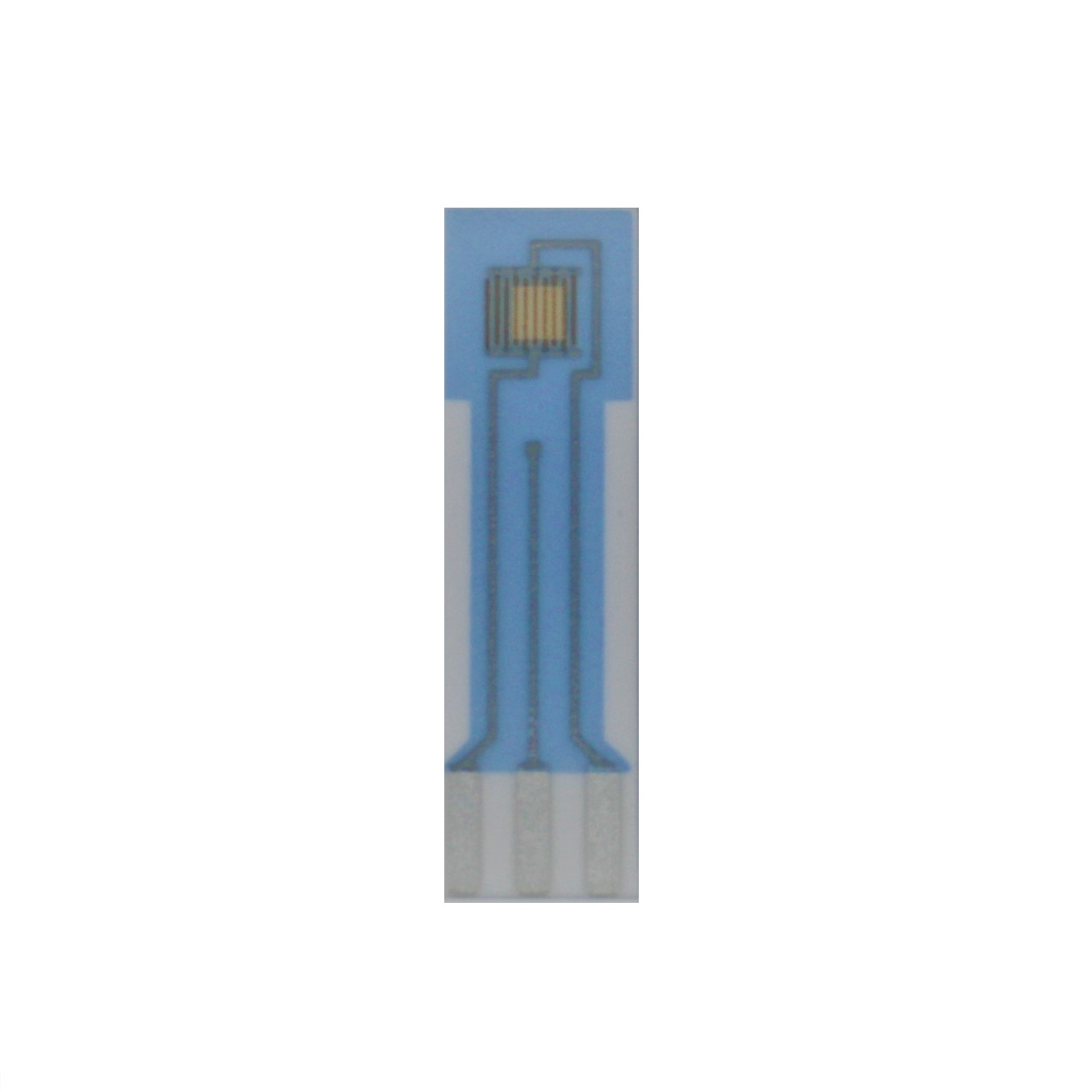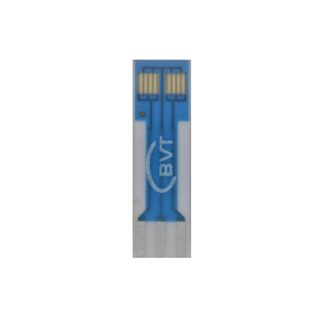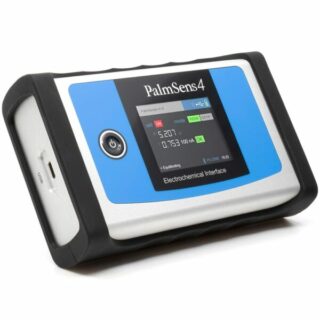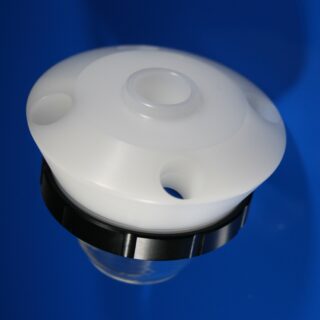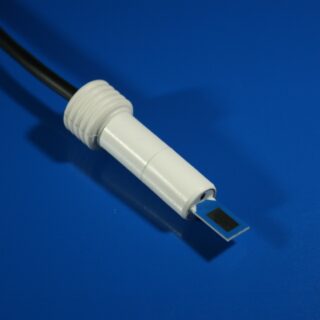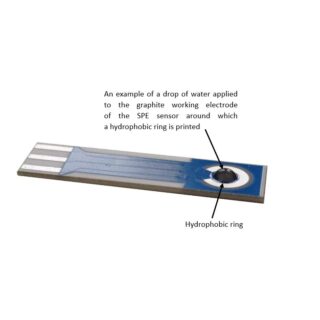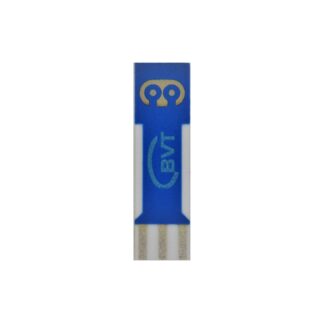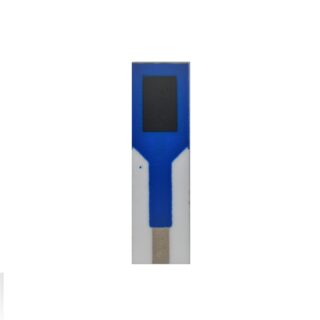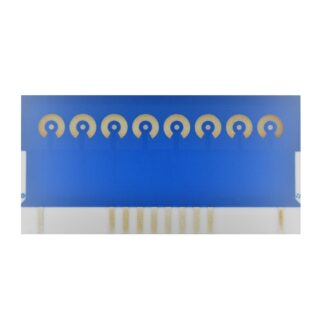Category
- Custom made glass products
- CUSTOMER SERVICES
- NEW PRODUCTS
- Sensors and electrodes
- Custom made and Modified Screen Printed Electrodes
- Stirrers
- Cables and connectors
- Cell
- Potentiostats
- Manual Screen Printer
- Minithermostat
- Pumps
- Accessories
- Kits & Sets
- Discounted SPEs (at a reduced price with visual defects/inconsistancies, but fully functional)
CC1 Electrochemical sensor
A conductivity sensor made by thick film technology with interdigitated structure of electrodes
Dimensions: 25.4 x 7.26 x 0.63 mm
WE material: Au/Pt, Au, Pt, Ag, C
The sensor is formed on a corundum ceramic base. Onto this surface two interdigitated structures of electrodes are applied. The electrodes are made of Platinum-Gold alloy in standard product CC1.WS. At the end of the sensor there is a contact which is connected with the active part by the silver conducting path which is covered by a dielectric protection layer. A bio-chemically active substance can be immobilised on the working electrode of the sensor.
Useful Documents
Description of Sensor Materials and Handling
Video – EIS measurement with CC1 sensor
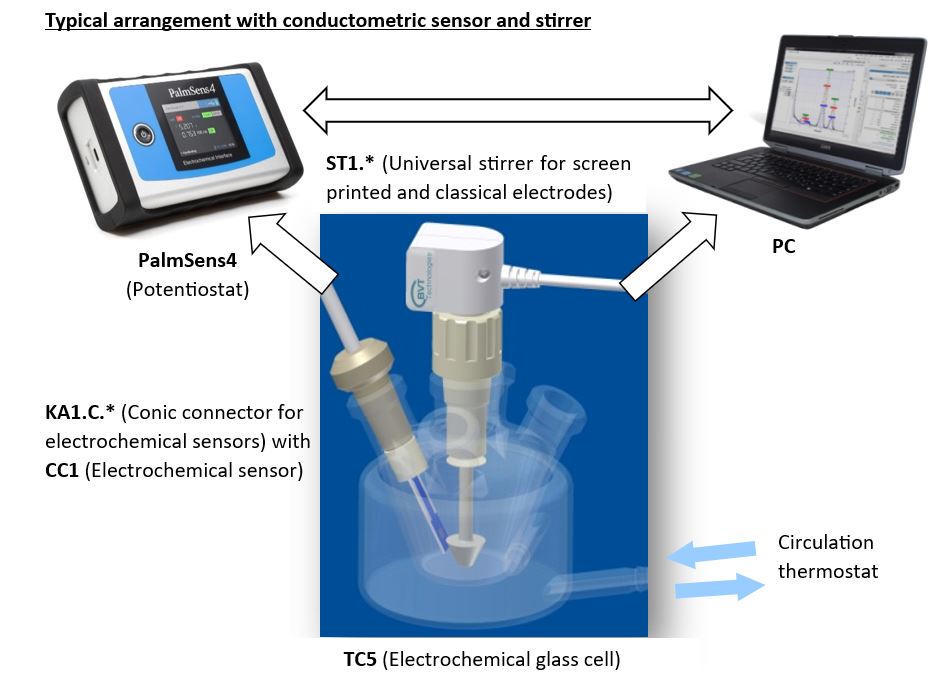
You may also like…
-
CC2 Electrochemical sensor
Read moreA conductivity sensor with two active parts made by thick film technology with interdigitated structure of electrodes
Dimensions: 25.4 x 7.26 x 0.63 mm
WE material: Au/Pt, Au, Pt, Ag, C
The sensor is formed on a corundum ceramic base. Onto this surface two interdigitated structures of electrodes are applied. The electrodes are made of Platinum-Gold alloy in standard product CC2.WS. At the end of the sensor there is a contact which is connected with the active part by the silver conducting path which is covered by a dielectric protection layer. A bio-chemically active substance can be put on the electrodes, one interdigitated structure, the second structure is reference.
-
PalmSens4
Read moreThe PalmSens4, is a USB and battery powered Potentiostat, Galvanostat, and optional a Frequency Response Analyser (FRA) for Electrochemical Impedance Spectroscopy (EIS).
Compact, versatile and powerful
- (Bi)Potentiostat / Galvanostat / Impedance Analyzer
- FRA / EIS: 10 μHz up to 1 MHz
- 9 current ranges: 100 pA to 10 mA
- 18-bit resolution
- Bluetooth or USB connection
The PalmSens4 has a large potential range (-5V to 5V or -10V to 10V) and current range (100 pA to 10 mA) with a high resolution and low noise. The economical PalmSens4 is a complete laboratory instrument but its compact and rugged design makes it also ideal for field work.
Connecting via Bluetooth guarantees a perfectly floating measurement.
More information can be found through the link: https://www.palmsens.com/product/palmsens4/
Configurable
PalmSens4 comes in different configurations:
- ±5 V or ±10 V potential range
- EIS/FRA with maximum frequency of 100 kHz or 1 MHz
- optional BiPotentiostat module for second WE
- optional iR-Compensation
Standard included
- Rugged carrying case
- High quality, double shielded cell cable with
2 mm banana connectors for Working, Counter, Reference electrode and Ground - Crocodile clips
- Dummy cell
- USB cable
- Manual and Quick Start document
- PSTrace software for Windows
-
TC6 Electrochemical Glass Cell
Read moreBorosilicate glass cell serves for electrochemical measurements.
The analyzed solution can be thermostated by minithermostat MT1-1.
Cell openings are designed for electrochemical sensors connector KA1.C, classical electrodes WCEc, ACEc, RCEc and stirrer ST1, ST3 separately.
The device enables the measurement with inserted samples.
-
KA4.* Connector for Electrochemical Sensors
Read moreThe connector enables the use of the electrochemical sensor/biosensor based on the substrates AC1, AC4, CC1, CC2 and TS1 in classical electrochemical arrangement. This connector has 6 contacts. Three contacts on the front side serve as contacts for 3-electrode system. Three contacts on the back side main purpose is to be used with AC1 (H, T) sensors that possess heating and temperature measuring termistor.
Related products
-
AC1. electrochemical sensor with a hydrophobic ring
Read moreElectrochemical sensor type AC1. with a hydrophobic ring – a hydrophobic layer is printed around the working electrode of the sensor (with a diameter of 1 or 2 mm), which ensures that the liquid applied to the working electrode of the sensor forms a drop and does not move outside to the reference and auxiliary electrodes (see the photograph below).
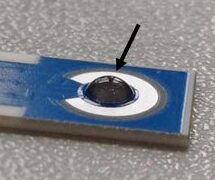
Such modification of the sensor is suitable, for example, before the next intended modification of only the working electrode of the sensor by the customer – for example, immobilization of a bioactive substance.
-
AC2 Electrochemical sensor
Read moreAmperometric two-electrode sensor with two working electrodes made by thick film technology.
Dimensions: 25.4 x 7.26 x 0.63 mm
WE material: Au/Pt, Au, Pt, Ag, C
The sensor is formed on a corundum ceramic base. On to this surface two working electrodes, and one reference electrode are applied. The working and the reference electrodes can be made of variety of materials. At the end of the sensor there is a contacting field which is connected with the active part by the silver conducting paths which are covered by a dielectric protection layer. Different bio-chemically active substance can be immobilised on the working electrode to create a biosensor.
-
AC4 Electrochemical sensor
Read moreAmperometric single working electrode sensor with a extremely big working electrode made by thick film technology
Dimensions: 25.4 x 7.26 x 0.63 mm
WE material: Au/Pt, Au, Pt, Ag, C
The sensor is formed on a corundum ceramic base. On to this surface working electrode is applied. The working electrode is made of variety of materials. At the end of the sensor there is a contact which is connected with the active part by the silver conducting path which is covered by a dielectric protection layer.
-
AC5 Electrochemical sensor
Read moreScreen printed electrochemical array of 8 working electrodes
Dimensions: 25.4 x 50.8 x 0.63 mm
WE material: Au/Pt, Au, Pt, Ag, C
The sensor is formed on a corundum ceramic base. On to this surface the working and the reference electrodes are applied. The working electrodes create an array of eight electrodes. The electrodes can be made of variety of materials (see below). At the end of the sensor there is a contacting field which is connected with the active part by the silver conducting paths which are covered by a dielectric protection layer. A bio-chemically active substance can be immobilised on the working electrodes of the sensor.

